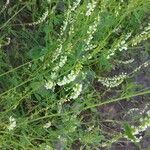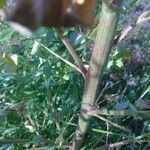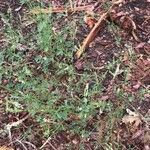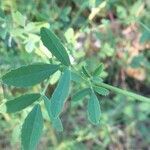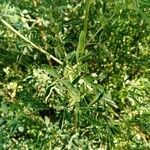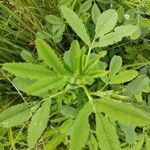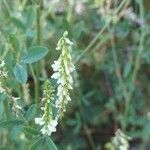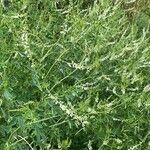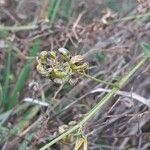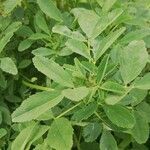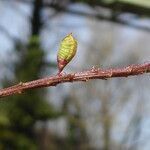Erect annual or biennial up to 2.5 m high; stems almost glabrous or sparsely to moderately hairy in upper parts. Lvs almost glabrous but sparsely hairy when young; petioles c. 5-25 mm long; leaflets oblong-elliptic to obovate, obtuse to acute, mucronate, obtuse to cuneate at base, serrate, c. 10-30 mm long; stipules linear-lanceolate, entire. Racemes lax and slender, up to 25 cm long at fruiting; fls numerous. Peduncles > petioles. Calyx ± glabrous to sparsely hairy; calyx teeth = or < tube, narrowly triangular. Corolla white, 4-5 mm long; wings ± = keel. Pod glabrous, reticulately veined, 3-5 mm long, 1-2-seeded; seeds light brown, 2-3 mm long.
Annual herb, up to 1.8 m high; much branched. Leaves with rachis of larger leaves, excluding terminal petiolule, often prolonged > 4 mm beyond lateral leaflets. Flowers: in many-flowered racemes; style 1.7-2.3 mm long; corolla white; Oct.-Apr. Pods with a weak, irregular network of veins, 3 mm long.
An annual or biennial herb. It grows 20-100 cm high. It is tall and bushy. The leaves are made up of 3 leaflets with teeth around the edge. The flowers are small and white. They are pea-like. The flowers and stalk are 5-20 cm long. The fruit is an oval wrinkled pod. It is 3-5 mm long and grey-brown.
Corolla white, ± twice as long as the calyx; standard c. 4 mm long, broadly oblong-ovate, distinctly emarginate at the apex; wings slightly exceeding the keel, with small, hooked auricles; keel c. 4 mm long, oblong.
Leaflets narrowly oblong-obovate to linear or elliptic, cuneate and entire at the base, denticulate around the upper half or more; stipules linear-subulate, entire.
Pod 3–5 mm long, globose-ovoid or subglobose, with a short, curved beak at the apex, weakly reticulately veined, ± brown when mature, glabrous.
Calyx c. 2 mm long; teeth narrowly deltoid, somewhat unequal (the lowest shortest), glabrous or somewhat appressed-hairy.
Flowers small, with pedicels 1.5–2.5 mm long, becoming deflexed in fruit.
Racemes many-flowered, up to 17 cm long, lax; peduncle up to 4 cm long.
Erect, branched annual herb.
Seeds ovoid, smooth.
